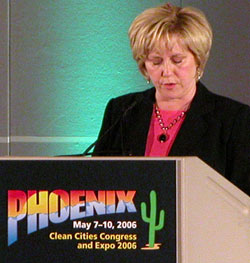 The lady who is making it all happen here in Phoenix is the Executive Director of the Alternative Fuel Vehicle Institute. She’s Annalloyd Thomason. Actually, I’m sure she’ll say it was a lot of effort from a lot of people. But she’s been in constant motion since I’ve been here working the radio and making sure everything is running smoothly.
The lady who is making it all happen here in Phoenix is the Executive Director of the Alternative Fuel Vehicle Institute. She’s Annalloyd Thomason. Actually, I’m sure she’ll say it was a lot of effort from a lot of people. But she’s been in constant motion since I’ve been here working the radio and making sure everything is running smoothly.
On the stage this morning Annalloyd welcomed the Congress participants.
You can hear her speech here:  Annalloyd Thomason Speech (6 min MP3)
Annalloyd Thomason Speech (6 min MP3)
Domestic Fuel coverage of the Clean Cities Congress is made possible by the following sponsors:




 Okay. One more post from this morning’s Senator John McCain speech.
Okay. One more post from this morning’s Senator John McCain speech.
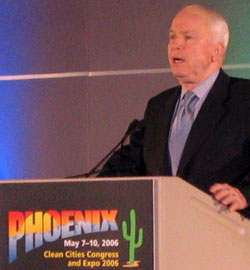 Rather than add this link to the full speech by
Rather than add this link to the full speech by 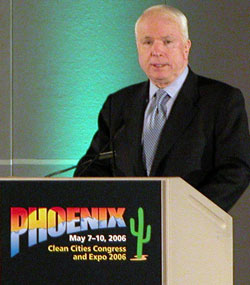 Senator McCain is speaking now and I’ll have his speech here for you in a little while. I’m going to try to get a personal interview with him on his way out too.
Senator McCain is speaking now and I’ll have his speech here for you in a little while. I’m going to try to get a personal interview with him on his way out too. Our opening session is underway. AFVI Executive Director Annalloyd Thomason is speaking right now. She just announced the Domestic Fuel coverage of the Congress. Thank you Annalloyd!
Our opening session is underway. AFVI Executive Director Annalloyd Thomason is speaking right now. She just announced the Domestic Fuel coverage of the Congress. Thank you Annalloyd! Everyone was having fun at the opening reception here at the Clean Cities Congress. It was definitely an extremely GM event.
Everyone was having fun at the opening reception here at the Clean Cities Congress. It was definitely an extremely GM event.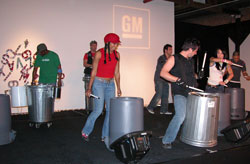 At our opening reception, hosted by General Motors we got to see a serious percussion performance. We went out to the
At our opening reception, hosted by General Motors we got to see a serious percussion performance. We went out to the 
 The folks at the Clean Cities Congress must be loving CBS.
The folks at the Clean Cities Congress must be loving CBS. 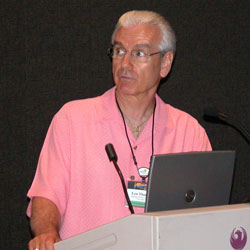 Fleet operators attending the Clean Cities Congress had a packed opening workshop presented by Leo Thomason with the
Fleet operators attending the Clean Cities Congress had a packed opening workshop presented by Leo Thomason with the